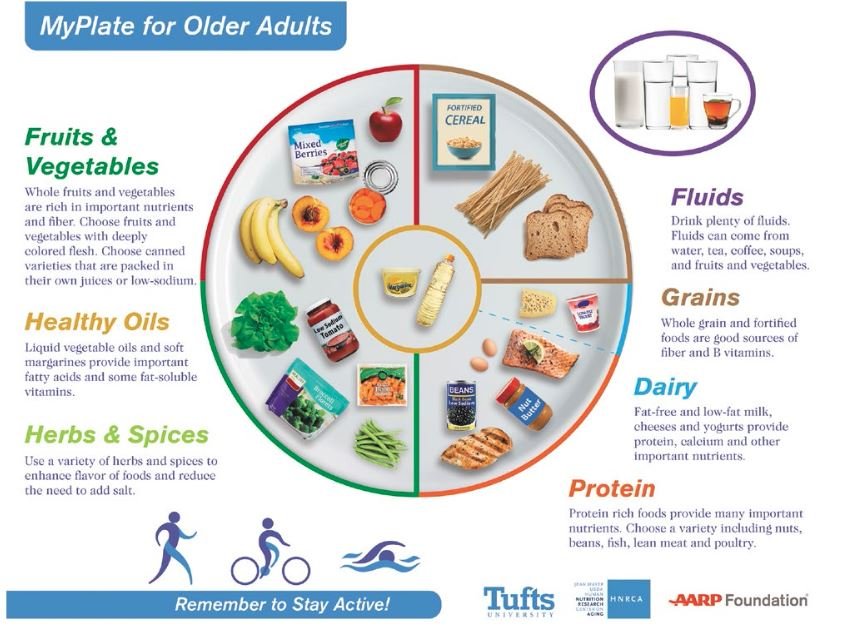In March 2016, nutrition scientists at Tufts’ Jean Mayer USDA Human Nutrition Research Center on Aging introduced an updated MyPlate for Older Adults, revised to reflect the latest Dietary Guidelines for Americans.
MyPlate for Older Adults calls attention to the unique nutritional and physical activity needs associated with advancing years, emphasizing positive choices. It shows how older adults might follow a healthy dietary pattern that builds on the MyPlate graphic below.
One important change as you get older is that your calorie needs typically decrease after age 50; men generally need 2,000 daily calories and women 1,600, depending on physical activity. But your vitamin and mineral requirements stay the same or may even increase—which can make it a challenge to get the nutrients you need from a smaller calorie intake.
So, MyPlate for Older Adults provides examples of foods that contain high levels of vitamins and minerals per serving. These choices are also consistent with the dietary guidelines, which recommend limiting foods high in trans and saturated fats, salt, and added sugars.

2016 Tufts University, all rights reserved. MyPlate for Older Adults graphic and accompanying website were developed with support from AARP Foundation. Tufts University and AARP Foundation are registered trademarks and may not be reproduced apart from their inclusion in the My Plate for Older Adults graphic without express permission from their respective owners.
The MyPlate for Older Adults illustrates:
• Bright-colored vegetables, such as carrots and broccoli
• Deep-colored fruit, such as berries and peaches
• Whole, enriched, and fortified grains and cereals, such as brown rice and 100-percent whole wheat bread
• Low- and non-fat dairy products, such as yogurt and low-lactose milk
• Canned beans and unsalted nuts, fish, poultry, lean meat, and tofu
• Liquid vegetable oils, soft spreads low in saturated and trans fat, and spices to replace salt
• Fluids such as water, soups, teas, and fat free milk
• Physical activity, such as walking, resistance training, and light cleaning
Nutrition for the Elderly
If you’re consuming fewer calories, it’s important to get as many nutrients from those calories as possible. MyPlate for Older Adults spotlights vegetables and fruits as nutrient-dense food choices that are convenient, affordable, and readily available. Half of MyPlate for Older Adults is made up of fruit and vegetable icons, which reflects the importance of eating several servings of fruits and vegetables per day in a range of colors.
Consuming a variety of produce with deep-colored flesh introduces a larger amount of plant-based chemicals, nutrients, and fiber into your diet. MyPlate for Older Adults also includes icons representing frozen, pre-peeled fresh, dried, and certain low-sodium, low-sugar canned options. That’s because fruits and vegetables in those forms contain as many or more nutrients as fresh and they are easier to prepare, are more affordable, and have a longer shelf life—all important considerations for older consumers.
MyPlate for Older Adults also features whole, enriched, and fortified grains because they are high in fiber and other beneficial nutrients.
Experts advise making at least half your grain choices whole grains.
Suggested protein sources include fish and lean meat as well as plant-based options, such as beans and tofu. For cooking and serving, the Tufts experts recommend vegetable oils and soft spreads (free of trans fats—check the label) as alternatives to foods high in animal fats because animal-based products, such as butter and lard, are higher in saturated fat.
Other icons represent regular physical activity, emphasize adequate fluid intake, and focus on seasoning with herbs and spices instead of salt.
To learn more about ways to improve your brain health, purchase your copy of Brain Power and Nutrition from The Friedman School of Nutrition Science and Policy at Tufts University.






















Good info. I sure need to include and eliminate items in my diet. I am 86 years old.
Patricia- Neat to see your comment. My Mom is 88. All best to you!
Go you, and may you live to reach 100 years young or more! God bless you! 🥰
Great information!!!
Are dairy products really necessary? Since they contain pregnant cow hormones, I prefer to get my calcium from almonds, veggies, and soy milk products. At age 67, my latest DEXA scan indicated that I have a low risk of fracture!
Did I read “limit” foods high in trans fat?? I always thought it was eliminate trans fats!
@Patricia Haugh I think you need to give advice! Looks to me at 86 and going strong you are doing things right!
A daily menu for two weeks with a shopping list would most helpful.
Why low lactose milk- I thought some ( 8 Oz ) 1 or 2% fat milk is great for calcium and contains Vit D- in a form that is well absorbed – only go low lactose if lactose bothers your GI system.
What does Tufts think about the fruits and vegetables in a jar that are advertised non-stop on television?
At 90 years of age physician, I have decades with Tufts Nutrition News Letter. Now we have alternatives to beef in the Beyond Products and Impossible burgers. As a physician I would like an analysis of these products, particularly for the aging population.
Happy to say my hubby Ralph and I are in our 90s now and still very active in walking, riding stationary bike, WII exercise 3 times a week and follow a diet similar to this one. Keep on staying active. Margaret
Appreciate and trust your newsletters for years. Thank you .
Dairy products do not contain ‘pregnant cow hormones.’ Pregnant cows are not lactating.
When I was young, 3-4 % of adults were obese. Now, 47% are obese. Hmmm…. maybe we could figure out this disaster in human health ..
Well, yes…… food ! Exercise ! Duh !
And guess what? Epigenetics will take this much further. And the medical profession, as brilliant as they might act , can’t do anything.
All dairy products contain cow hormones. Dairy milk is designed by nature to put weight on a baby calf rapidly. If you want to lose weight and reduce your risk of hormone-related cancers, try going dairy-free for a few weeks. You’ll be amazed at how good you feel!